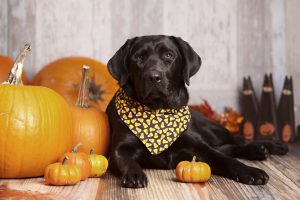Halloween Pet Safety Tips
Keeping your pet safe on Halloween doesn’t have to be tricky. Your friends at Prairie Ridge Veterinary Clinic have compiled a list of Halloween pet safety tips to keep your cats and dogs safe.
Candy = Not for Pets
Chocolate (especially baking or dark) can be lethal to your fur-pals. Symptoms of chocolate poisoning include vomiting, diarrhea, rapid breathing, increased heart rate and seizures. Candies containing the artificial sweetener, xyilitol, are also very dangerous to pets. Even small amounts can cause low blood sugar (hypoglycemia) liver failure, seizures, and even death. Lollipop sticks and plastic candy wrappers can also be a choking hazard or could potentially cause an intestinal blockage. If you are worried your pet ingested a toxic substance, call your veterinarian immediately or the ASPCA Poison Control Hotline at 888-426-4435.
Outdoor Pet Safety on Halloween
Do not leave pets outside in the yard. Vicious pranksters have been known to steal, tease, injure and even kill pets on Halloween night. Believe it or not, cats (especially black cats) are at a higher risk for cruel tricks and pranks. Leave outside cats inside several days before and after Halloween.
Create a Safe Haven
Most dogs are not accustomed to the excitement of Halloween. Masks change how people look and smell to pets so even familiar visitors may seem intimidating. Strangers dressed in unusual clothing, screaming for candy can be a nightmare to our furry friends. Dogs can become territorial, nervous, and may even growl or bite in defense. Keep them confined in a secure and comfortable room or somewhere away from the constantly opening and closing front door. This will also help prevent an escape artist from darting out the door.
Dangerous Decor
Halloween plants such as pumpkins and corn can cause gastrointestinal upset if ingested in large amounts. Colitis (inflammation of the large intestine or colon) and pancreatitis (inflammation of the pancreas) can also occur after a dietary indiscretion. Be sure to keep wires and electric light cords out of reach. If chewed, electrical shock and death can occur. Other decorations such as glow sticks or glow jewelry, fake cobwebs, rubber spiders/eyeballs can pose choking hazards. If big enough pieces are swallowed, intestinal blockages can occur and often require surgery. Keep jack-o-lanterns and open flames away from pets; curious kittens can get burned or knock a candle over and start a house fire if left within reach.
Costumes for Pets
Make sure a costume for your pet does not inhibit movement, hearing, sight, or the ability to breathe and bark/meow. Try on costumes before the “big night” and never leave costumes on with pets unsupervised. Small pieces can easily be chewed off and swallowed, potentially causing a blockage. Make sure your pet is always comfortable and choose a brightly-colored costume so people and vehicles can easily see your fury trick-or-treater.
Can We See Some ID?
ALWAYS make sure your pet has proper identification on at all times, but especially Halloween night. If your pet is lost, having a name tag with the pet’s name, your name, address, and phone number will help bring your pet home faster. Always make sure the information on the tag or microchip is up-to-date; if you move or change your telephone number, make sure you change the tag information also.
With a few adjustments, Halloween can be fun for all of your furriest family members. If you have any other questions about Halloween pet safety tips, call us at 309-543-2091. From your friends at Prairie Ridge Veterinary Clinic, we wish you and your pet a happy and safe Halloween!
“Dr. Yetter’s professional & compassionate care enabled us to have Lady as a member of our family for over 17 years. Through his knowledge, extensive research, and willingness to reach out, he provided Lady with a long quality life in spite of numerous health issues. We are eternally grateful.”
— Diane & Terry Svob
“Dr. Yetter and the staff at Prairie Ridge have given excellent care to my family of pets for about 20 years. I always feel comfortable asking questions and knowing I will get complete, caring answers. Dr. Yetter researches to find the best treatment options. My cats and dog are family to me, and we trust Prairie Ridge Veterinary Clinic.”
—Janis Blout
“We are so grateful for the hard work and extra research Dr. Yetter did for our Tansy-cat to find out why she wasn’t eating. If there is a time when your most precious friend is ill and you need to trust someone to care for them, Dr. Yetter is definitely that person! He went above and beyond to do everything he could to save our beautiful Tansy.”
— Tom & Bev Berberett
“My pets have been patients of Dr. Yetter and his great staff for many years, and I have always been grateful for their efficiency and helpfulness. Having good care right here in Havana is a big plus!”
— Jan McFarlin
“I began to bring in my labs into PRVC when I started working there, and was happy to have such a caring and knowledgeable doctor to take care of two of my best friends. It always amazes me just how much care goes into each and every animal, let alone the perseverance of Dr. Yetter and staff (I should call them family) in working out how to treat each and every problem.”
— Chris Johnson


